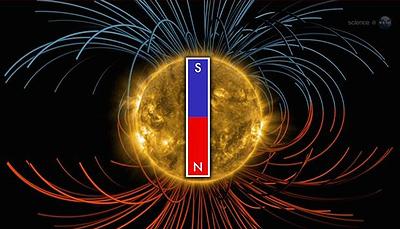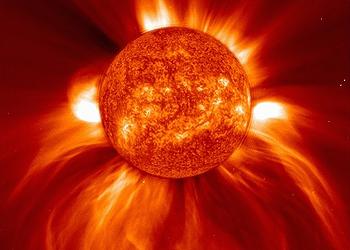Sun’s Magnetic Field Forecast to Flip by Year End
STANFORD, California, August 6, 2013 (ENS) – The Sun’s giant magnetic field is forecast to reverse itself sometime in November or December with consequences for the entire solar system, according to measurements from NASA-supported observatories. Such solar disturbances can cause geomagnetic storms in Earth’s magnetic field, affecting communications, power lines and satellites.
“It looks like we’re no more than three to four months away from a complete field reversal,” says solar physicist Todd Hoeksema of Stanford University. “This change will have ripple effects throughout the solar system.”
Hoeksema is the director of Stanford’s Wilcox Solar Observatory, one of the few observatories in the world that monitor the Sun’s polar magnetic fields. The Wilcox Solar Observatory began daily observations of the Sun’s global magnetic field in May 1975, with the goal of understanding changes in the Sun and how those changes affect the Earth; this is now called space weather.
The Sun’s magnetic field changes polarity approximately every 11 years. It happens at the peak of each solar cycle as the Sun’s inner magnetic dynamo re-organizes itself, explains NASA’s Dr. Tony Phillips. “The coming reversal will mark the midpoint of Solar Cycle 24. Half of ‘Solar Max’ will be behind us, with half yet to come.”
Solar activity, such as sunspots and coronal mass ejections, increases during solar maximum, resulting in more active space weather around Earth,
When coronal mass ejections hit the Earth they can affect the Earth’s magnetic field, said NASA’s Dr. Eric Christian during the last solar reversal 11 years ago. “This change in the magnetic field can cause back-currents in power lines that have caused power failures like the one in Montreal. They can also degrade oil pipelines, cause increased atmospheric drag on satellites, disrupt communications, and the particles can even directly harm satellite electronics or astronauts,” he said.
These outbursts can happen at any time, but the biggest ones, which do the most damage, tend to happen when the Sun is at the maximum of its variable intensity every 11 years.
Just as Earth scientists watch our planet’s polar regions for signs of climate change, solar physicists do the same thing for the Sun. Magnetograms at Wilcox have been tracking the Sun’s polar magnetism since 1976, and they have recorded three grand reversals, with a fourth coming before year’s end.
Astronomers at the Wilcox Solar Observatory monitor the Sun’s global magnetic field on a daily basis. Stanford University operates Wilcox, with all funding currently provided by NASA.
Solar physicist Phil Scherrer, also at Stanford, describes what happens, “The Sun’s polar magnetic fields weaken, go to zero, and then emerge again with the opposite polarity. This is a regular part of the solar cycle.”
A reversal of the Sun’s magnetic field is, literally, a big event, says NASA. The domain of the Sun’s magnetic influence, also known as the “heliosphere,” extends billions of kilometers beyond Pluto. Changes to the field’s polarity ripple all the way out to the Voyager probes, on the doorstep of interstellar space.
When solar physicists talk about solar field reversals, their focus often centers on the “current sheet,” a surface jutting outward from the Sun’s equator where the Sun’s slowly-rotating magnetic field induces an electrical current.
The current itself is small, only one ten-billionth of an amp per square meter (0.0000000001 amps/m2), but the amperage flows through a region 10,000 kilometers thick and billions of kilometers wide. Electrically speaking, the entire heliosphere is organized around this enormous sheet.
During field reversals, the current sheet becomes very wavy. Scherrer says that as the Earth orbits the Sun, our planet dips in and out of the current sheet.
Transitions from one side of the current sheet to another can stir up stormy space weather around the Earth.
Cosmic rays are also affected. These are high-energy particles accelerated to nearly light speed by supernova explosions and other violent events in the galaxy. Cosmic rays are a danger to astronauts and space probes, and some researchers say they might affect the cloudiness and climate of Earth.
The current sheet acts as a barrier to cosmic rays, deflecting them as they attempt to penetrate the inner solar system. A wavy, crinkly sheet acts as a better shield against these energetic particles from deep space.
As the field reversal approaches, data from Wilcox Solar Observatory show that the Sun’s two hemispheres are out of synch.
“The Sun’s north pole has already changed sign, while the south pole is racing to catch up,” says Scherrer. “Soon, however, both poles will be reversed, and the second half of Solar Max will be underway.”
(0)As the sun reaches a crescendo in its 11 year activity cycle this year, it’s also getting ready to go topsy-turvy.
The sun’s global magnetic field is about to reverse—flipping its orientation so that north becomes south and south becomes north. Astronomers estimate that we may be only three or four months away from this mysterious solar magnetic field reversal.
This magnetic field flip occurs every 11 years as the sun reaches the mid-point of the solar maximum, a period of increased solar activity . Scientists monitoring the sun during its current cycle say that the sun’s inner electromagnetic dynamo—produced by the rotation of its plasma and the outward flow of energy—is about to change orientation between the northern and southern hemispheres.
The effects of the pole reversal will reverberate well beyond the sun. While there’s no need to worry about any Hollywood-type doomsday scenarios, this natural, ongoing solar event can create stormy space weather and intensify the geomagnetic storms that will buffet the Earth in the coming year. For skywatchers, this may translate into some beautiful auroras this coming season.
Even the protective bubble at the edge of the solar system, called the heliosheath—which lies billions of miles beyond Pluto and shields the planets from damaging cosmic radiation—is under the influence of the sun’s magnetic field. The heliosheth will feel the effects of this magnetic flip and become more robust. The improved shielding from cosmic radiation—while temporary— will directly benefit spacewalking astronauts and satellites vulnerable to these energetic, and destructive, particles .
Flip of Sun’s Magnetic Field to Trigger Storms Across Globe [VIDEO]
By Hannah Osborne: Subscribe to Hannah's RSS feed | August 7, 2013 9:29 AM GMTThe sun's magnetic field is getting ready to flip over, an event that will have a ripple effect throughout the solar system and produce stormy weather on Earth. The Sun's current sheet becomes wavy during a magnetic flip (Nasa)
The Sun's current sheet becomes wavy during a magnetic flip (Nasa)
Measurements from Nasa's observatories show that the sun's magnetic field is preparing to change polarity - a change that takes place once every 11 years. The last magnetic flip, or Solar Maxim, took place in 2000.
Todd Hoeksema, a solar physicist from Stanford University, said: "It looks like we're no more than three to four months away from a complete field reversal. This change will have ripple effects throughout the solar system."
Solar physicist Phil Scherrer, also from Stanford, described what happens: "The sun's polar magnetic fields weaken, go to zero and then emerge again with the opposite polarity."
The flip takes place at the peak of each solar cycle, when the sun's inner magnetic dynamo re-organises itself. The reverse marks the midpoint of the cycle.
The sun's magnetic influence extends billions of kilometres beyond Pluto and changes to the field go all the way out to Voyager probes, "on the doorstep of interstellar space", Nasa said.
Scientists have been tracking the sun's polar magnetism since 1976. The forthcoming flip will be the fourth recorded since then, but historical weather events may be attributed to a Solar Maxim.
Stormy, cloudy weather
In 1859, a solar storm was recorded and saw solar flares appearing all over earth. It was so strong that the Northern Lights, a natural light display normally only visible in the Arctic and Antarctic regions, could be seen in Rome.
Solar physicians focus their attention on the 'current sheet', when speaking about solar field reversals. The current sheet is a surface jutting out from the sun's equator.
The sun's rotating magnetic field creates an electrical current, which itself is very small, at around one ten-billionth of an amp per square metre. However, there is a lot of current, and it flows through a region 10,000km thick and billions of kilometres wide.
During magnetic field reversals, the current sheet becomes wavy and as Earth orbits the sun, it dips in and out of the current sheet, resulting in stormy weather across the planet.
Cosmic rays will also be affected, creating a danger to astronauts and space probes - cosmic rays are high-energy particles accelerated to almost light speed by supernova explosions and other violent events.
Researchers believe these cosmic rays may also affect the cloudiness and climate of Earth.
Scherrer said: "The sun's north pole has already changed sign, while the south pole is racing to catch up. Soon, however, both poles will be reversed, and the second half of solar max will be underway."
To report problems or to leave feedback about this article, e-mail: h.osborne@ibtimes.co.uk
To contact the editor, e-mail: editor@ibtimes.co.uk
Sun's Magnetic Field About To Completely Flip, Bringing Stormy Space Weather To Earth
Huffington Post UK | By Chris York Posted: 07/08/2013 08:49 BST | Updated: 07/08/2013 08:49 BST
The Sun is about to flip out.
Its magnetic field is set to do a complete 180, changing poles as the nurturer of all life on Earth reaches the halfway point of "solar maximum".
Should you start digging a shelter in your garden? Well, not quite.
The phenomenon happens around every 11 years as the Sun reaches the peak of its solar cycle.
Physicist Phil Scherrer soothed our terrified minds and said: "The sun's polar magnetic fields weaken, go to zero, and then emerge again with the opposite polarity.
"This is a regular part of the solar cycle."
That's not to say is isn't a significant event. The sun's heliosphere - the domain of its magnetic influence - extends far out beyond Pluto in what scientists refer to as a "sheet".
A flip in the magnetic field causes ripples in this. As the Earth passes in and out of the sheet "stormy space weather" can occur around our planet.
Scherrer and fellow physicists have been monitoring the Sun from Stanford University's Wilcox Solar Observatory and expect the flip to happen in around three to four months.
He said: "The sun's north pole has already changed sign, while the south pole is racing to catch up.
"Soon, however, both poles will be reversed, and the second half of Solar Max will be underway."
Amazing Space Photos1 of 60
- Contribute to this Story:
- Send us a tip
- Send us a photo or video
- Suggest a correction
FOLLOW UK TECH
I am a chosen prophet by the Lord Jesus. I speak Chinese and Minnan as my first language. And, I speak English as my second language. I am a C1 user of the TOEIC and TOEFL-ITP's grammar. My TOEIC is 920 and TOEFL-ITP 617. And, my Structure & Written Expression of my TOEFL-ITP is 66 out of 68.
Wednesday, August 7, 2013
Sun’s Magnetic Field Forecast to Flip by Year End August 6, 2013
Subscribe to:
Post Comments (Atom)





 Print
Print


